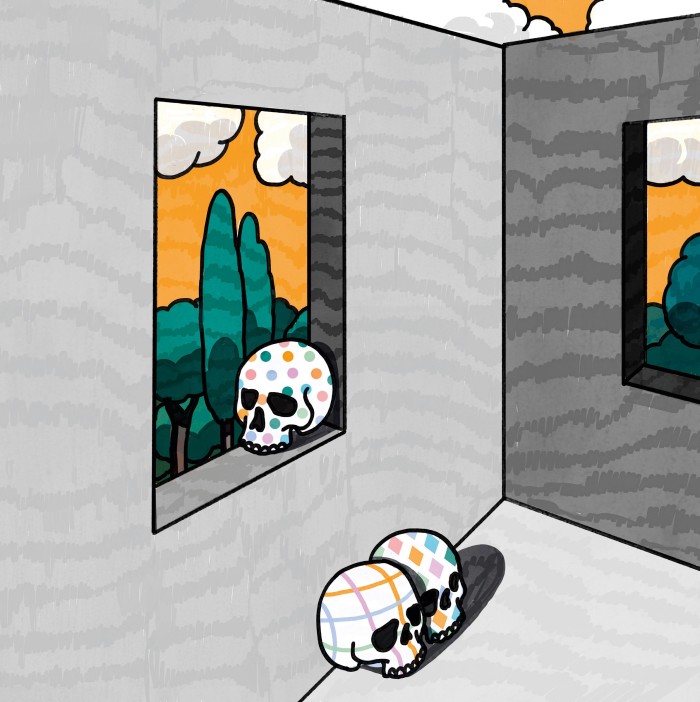How I Spend It: Chuck Palahniuk on skulls

Simply sign up to the House & Home myFT Digest -- delivered directly to your inbox.
My skulls have found a final resting place. The first ones I bought in the desert under a blazing sun, in a remote yard selling garden ornaments. Five human skulls cast from concrete, they were sitting half submerged in a pool of brackish water, black with slime and staring skyward. The woman who’d made them told me her concrete Buddhas and gnomes sold well, but these skulls had sat unwanted for years. So she gave me a deal: all five for $20, total.
I had yet to grow my first grey hair. Back then, the so-called “gothic garden” was in vogue – woody herbs and bits of broken trefoils and quatrefoils propped in beds or mortared among the paving stones. Gargoyles leered out of every horticulture magazine. Unable to afford a house and garden, I could stockpile skulls. Some came from an artist convinced his work would moulder faster if he mixed the cement with aggregate and his own urine. For the bacteria, you know. These smelly skulls I socked away with my growing collection. Other skulls I bought from a homeless artist who mixed and cast a few at a time in her old car and sold them on the street. By that time, I could afford to shell out $20 for each, and hers were carefully detailed, down to the sutures and the exact shape of the bicuspids.
By then I had a house, I’d written Fight Club and a dozen other books. I’d written graphic novels and colouring books and a travel guide, and much of my income had gone to buy a ramshackle house situated on a rocky point of land. Only Bram Stoker or Edgar Allan Poe could imagine such a location. The precipice hangs above the Columbia River, which at this point is a mile wide, and directly across this river sits a strange little castle called Vista House, perched on a steep basalt promontory called Crown Point. Google them. Aeons ago, massive floods scoured the cliff faces clean, and barren stone monoliths – Rooster Rock, the Bridal Veil columns, Beacon Rock – tower over the river’s edge, shaggy with moss and ferns. Waterfalls abound.
For half the year hurricane-force winds blow, until the towering fir trees are denuded on their eastern sides and the gigantic white oaks twist and hang over the cliffs. It is the landscape of Wagner or Lovecraft; Arcadian, with stone walls built by Basque shepherds over a century ago, and a reproduction Italian Renaissance palace called Maryhill built and abandoned by a railroad baron. He also built a full-sized restored replica of Stonehenge – as a memorial to the first-world-war dead. These romantic landmarks are my neighbours, although I haven’t a human neighbour within a mile and a half.
A few years ago I set out to make my contribution to the scenery. On a small knoll, hidden until you stumble upon it, suspended above the river, I built the foundations for two intersecting walls. My vision was for two tall stone walls, a couple of peaked stained-glass windows, a ruin that would tempt people to walk the length of a long trail in order to get a better look. The view from the ruin – of the river, the monoliths, the castles – would be framed by my windows and stonework.
My childhood I’d spent cleaning used bricks and mixing mortar for my father and grandfather. The caustic lime smell of wet concrete is for me what baking cookies is for other people. Dump trucks deliver my rock, mostly two-man chunks of basalt, and I wash and sort and cart it and eventually assemble the stone into walls that now form rooms. The rooms enclose courtyards and offer niches for statues. During winter, deer shelter in these rooms. Summers, they’re alive with striped chipmunks and my dogs and me, building yet more foundations and rooms. And mortared in among the stones my skulls have at last come to rest. Black with age, green with mildew, the skulls leer from crevices and window frames. Some skulls are almost completely hidden by the rocks around them. Others are grouped tightly together to suggest an ossuary. Native vines and bushes crowd everything.
Last Halloween, a kindergarten class held a party among the stained glass and skulls flickering in light from a bonfire. Otherwise the surrounding woods are dense and so dark the constellations look like textbook illustrations. It was the kids who dubbed it “the scary castle”.
Recently, my husband, Mike, walked the long forest path and surveyed the ruins, the skulls, the gothic view. He told me, flat out, “I think the scary castle is big enough.”
The foundations are already laid for another year’s building. Just a few more rooms.
I think Mike is wrong.
Consider This: Moments in my Writing Life After Which Everything Was Different by Chuck Palahniuk is published by Little Brown
Comments